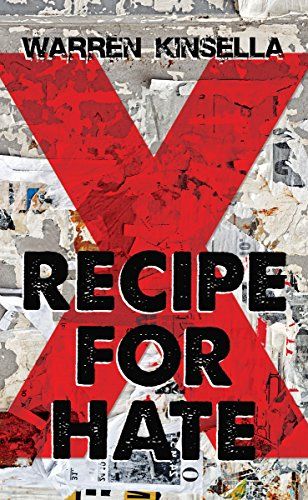Review: Recipe for Hate by Warren Kinsella

This review was originally written for Maximum Rocknroll, but ended up unpublished because the press did not meet MRR’s independence requirement.
In upwardly mobile South Portland, Maine, a group of teenage punks find themselves facing the looming threat of a serial murderer. It’s 1979, the Clash is the only band that matters, and the X Gang—led by the mysterious Christopher X and his right-hand man Kurt Blank—are determined to bypass the toothless Portland Police and secure justice for their fallen comrades. Their tools: a hand-distributed newspaper, a connection with a local reporter, and a few grizzled bikers who let the kids play shows at their dive bar. As more punk kids turn up dead, the X Gang tangles with the law, love, and white power skinheads as they search for the truth.
Let’s get this out of the way: Warren Kinsella didn’t likely have 30-year-old Maximum Rocknroll reviewers in mind when he wrote his YA novel Recipe for Hate. The title comes from a 1993 Bad Religion song with lyrics that sound like a nursery rhyme for angry teenagers with overactive vocabularies. And that makes some sense: all the main characters are angry teenagers with overactive vocabularies, and they’re insufferable. They literally call Joe Strummer the Messiah, reference “Anarchy in the UK” as if it were a sacred text, and pin every weak argument about the 1970s mainstream on potsmoking Zeppelin fans. The story is framed as a first-person account written by Kurt Blank, whose narration feels juvenile at best. Clichés abound, from “X was always an enigma wrapped in a mystery” to “But on that fateful night…” and what passes for characterization often comes in the form of tedious blocks of exposition that rarely advance the story. Kurt clearly hasn’t learned the “show, don’t tell” dictum, and I spent most of the novel trying to figure out whether that was a conscious authorial choice; I’m still not convinced. The narration often slides into third-person for events that take place outside of Kurt’s perspective, and while asides like “Patti later told me” attempt to smooth over those shifts, even this pretense gets dropped for entire chapters late in the book.
Recipe for Hate exists somewhere on a continuum with S.E. Hinton’s The Outsiders, another novel of youthful rebellion that puts its gang of colorful protagonists at odds with a prevailing culture that doesn’t understand them. In both books the conflict turns deadly, albeit for different reasons. The casualties in Hinton’s novel are largely tragic accidents, whereas Kinsella’s X Gang is directly targeted, marked for death by a murderer on the loose. So while The Outsiders quietly deals with class struggle through the lens of the teen rumble, there’s an elegance and universality to that classic novel—which even uses a similar narrative framing device—that gets lost in the weeds here. Recipe for Hate thrusts its white, middle-class punks into a victimhood they didn’t earn.
Self-styled as the “Prince of Darkness” of Canadian politics, Warren Kinsella is a writer, reporter, and political consultant with longstanding ties to Canada’s Liberal party. This book is billed as “based on real events,” which seem to be the murders of members of the press by white nationalist organizations in the mid-1980s. And Kinsella knows his stuff when it comes to the X Gang’s antagonists, having written multiple books on the rise of the far-right in North America. In Recipe for Hate he combines his professional knowledge with his own experience as a teenage musician in Calgary’s early punk scene—an era he must remember fondly, considering its romantic treatment here.
Recipe for Hate often reads like subculture fan fiction, and this isn’t helped by Kinsella inserting his real-life band the Hot Nasties into the story from the very start, with the kids spending the first scene crowing over an NME review of their self-released EP. That EP actually exists—and it’s even pretty good—but it definitely didn’t get them signed to Stiff Records, as it does in the novel. Kurt and Christopher X are punk rock Mary Sues, quiet and cool and wise beyond their years. They carry lead pipes for defense and don’t take shit from anybody; they hate authority and have cool scars. X never cries and looks like a buff Joey Ramone. They go to see the Clash in Boston, and of course they get to meet Joe Strummer, who even knows about the Portland punk murders. Even when the murder mystery plot does create some legitimate moments of tension, they’re consistently undermined by what feels like blatant wish fulfillment. And though the nationalist politics behind the X Gang murders were absolutely a real problem in 1979, white supremacists killing white punks rings pretty hollow when it’s true minorities—not misunderstood, middle-class teenagers—who continue to bear the brunt of the far-right’s damage.
The question, then, is who was this written for? The easy answer is rebellious, politically engaged teenagers, and it’s not hard to believe that a kid who just bought Never Mind the Bollocks might find something here to get excited about. But scratch the surface a little bit and the question still stands; I’m honestly not sure how relevant the 1979 punk experience would be to 2018 adolescents. The first wave of punk might as well be classic rock now. Even when I was a teenager, the kids who rejected contemporary sounds in favor of “real music” were just as likely to listen to Led Zeppelin as the Clash. It’s all music made by dead or aging white dudes, and while I certainly won’t deny its cultural importance, we can’t expect the vanguard of teenage rebellion to turn to their parents’ music for guidance. S.E. Hinton wrote The Outsiders as a junior in high school, and as a result the Greasers feel real enough to transcend their time period; the X Gang is trapped in a romanticised 1979 because they’re a memory.
Dundurn Press: dundurn.com; 3 Church St, Suite 500, Toronto, ON M5E 1M2 Canada